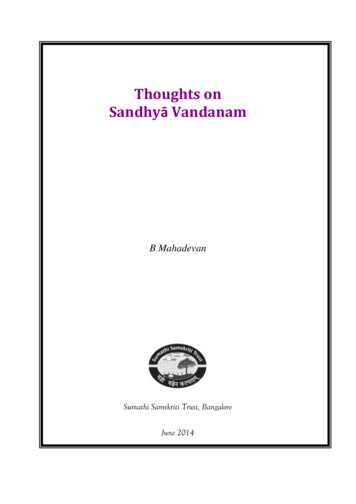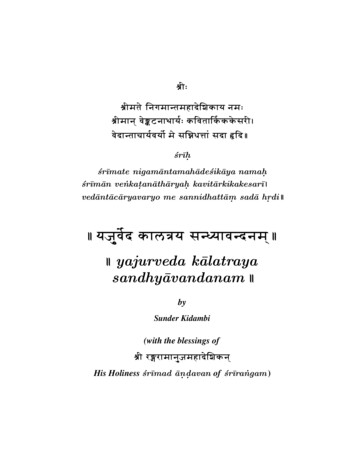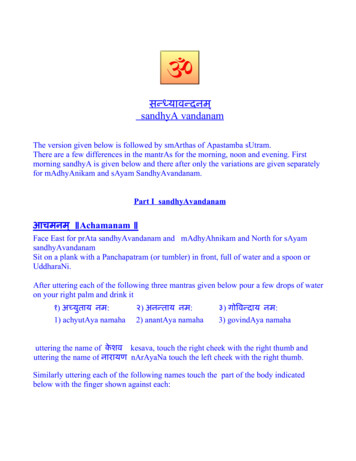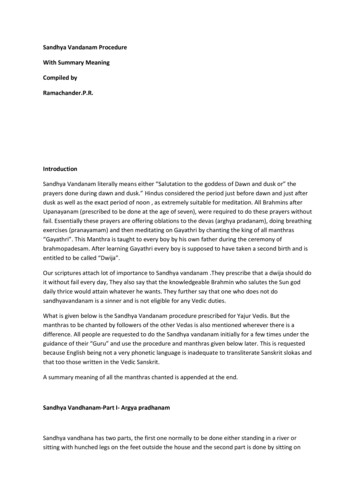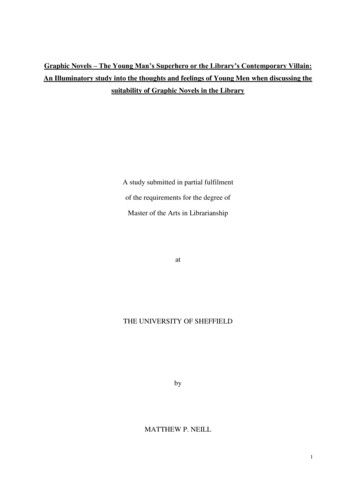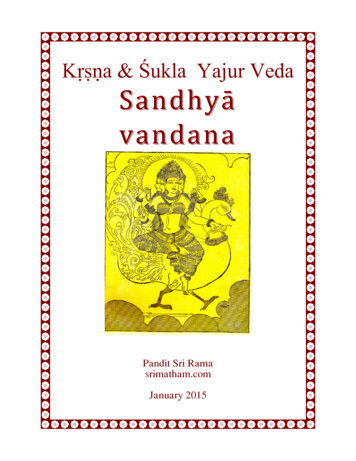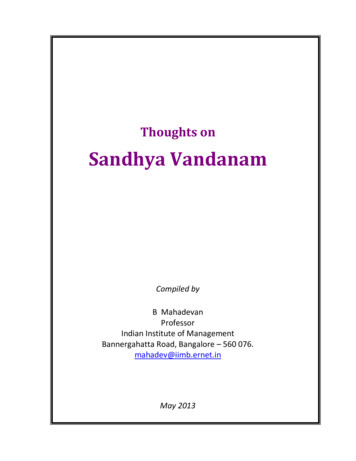
Transcription
Thoughts onSandhya VandanamCompiled byB MahadevanProfessorIndian Institute of ManagementBannergahatta Road, Bangalore – 560 076.mahadev@iimb.ernet.inMay 2013
PrefaceWe are living in an era characterized by scientific discoveries of various kinds. In thelast two hundred and fifty years we have discovered new technologies one after theother. These have played a major role in shaping our thinking and the way of life.However, more importantly, as a nation, we have also been introduced to a numberof ideas from the western civilizations. One important impact of this is a generalfeeling among an average, well-meaning educated Indian that anything of westernorigin is good, credible and the way to go forward. Even the traditionally educatedpandits in the country crave for recognition of their scholarship by the westerneducated group. With the result there is a widespread feeling that anythingworthwhile must pass through the lens of western acceptance.The recent onslaught of mass media and computers and the success of mediaconvergence as a reliable technology seems to accelerate this process. As a resultthere is a heightened exposure to other social structures and practices across theglobe. Indian society is fast joining the global melting pot of culture and socialpractices.Imbibing newer ideas and practices is generally viewed as a sign of evolution andgrowth. However, replacing altogether one set of cultural practices with anotherdoes not amount to evolution. At times it can be counter-productive and retrogradein nature. Therefore, giving up one’s own native culture and social practices is not ahealthy idea for any society. The Indian society is preparing to make such a choice.However, there is ambiguity and confusion among the citizens about the pros andcons of such a choice. With the result a vast majority of our population are like caton the wall not knowing what to do.Interestingly, on the other side, there is a growing interest among the youngsters toknow more about the Indian traditions. Current educational policies and practicesencourage them to “question” everything. This is in sharp contrast to the AncientIndian paradigm of having a very healthy “spirit of inquiry”. A natural extension ofthis attitude has resulted in them wanting to know more about some of the ancestralknowledge and cultural practices that we follow even today. Honestly, a vastmajority of youngsters are simply clueless about various facets of Ancient Indianwisdom. They are anxiously waiting for someone to discuss these in a language and aformat that they are used to.Ancestral Indian wisdom is rich, multi-faceted and profound. It offers grandparadigms for living and setting goals for one’s own progress in life. It also hasmultiple perspectives on some of the important issues such as attaining peace,tranquility and contentment. These are organized systematically in several layers.Sruti, which is otherwise known as Vedas and Upanishads has defined governingprinciples for life. On the other hand, Smrtis have detailed them and provided usefulguidelines for day-to-day living. The Dharma Sastras provide these details andspecify Saamaanya and Vishesha dharmas. They also point to Nitya and Naimittikakarmas that everyone must follow.
Sandhya Vandanam is the basic and most fundamental Nitya karma to be followedby Brahmins, Kshatriyas and Vaisyas belonging to all the four ashramas. However,unfortunately in the current context of jet setting and hectic life styles many haveabandoned this important duty. Many others are performing half-heartedly, notknowing what they are doing and why. There are still many more who have beendiligently following the practice of performing Sandhya Vandanam three times daily.This booklet has been prepared keeping a target group of youngsters and officegoers in mind. This group has always been having a question about the usefulness ofthis karma, its importance and its primacy in our scheme of daily living. Since Englishhas become the defacto medium for all and the sundry, this has been written inEnglish. The choice of the language and the style of writing are such that the targetaudience will be able to read it with ease and relate the ideas without muchdifficulty.However, it does not mean we need to compromise on the original intent andmessages that our ancestors have with respect to Gayatri mantra and SandhyaVandanam. Therefore, while compiling various ideas I have quoted generously fromearlier writings, Dharma Sastra and other texts that I have been able to go throughto the extent possible.I do not claim expertise in the subject matter. I have been greatly benefitted byreading three commentaries on Sandhya Vandanam. The first is a two part essay inKannada by His Holiness Jagadguru Sri Abhinava Vidya Teertha Maha Swamigal ofSringeri Sharada Peetham. One essay was on Gayatri Mahima and the other onSandhya Mahima. These essays were subsequently translated into Tamil byChanganur Subramaniya Aiyar Trust, Coimbatore and published in 1999 by SriSharada Trust, Bangalore.The second source is a bhashya on Sandhya Vandanam by Srivatsa Somadeva Sarma,the founder of Vaidika Dharma Vardhini, Chennai. This bhashya was published inTamil in 1952. The third source was the Sandhya Vandanam Bhasya by “Anna” andpublished by Ramakrishna Math, Mylapore, Chennai in 1956. I was also greatlybenefited by the book “Samkshepa Dharma Sastra” written in Tamil by ManjakudiVenkatrama Sastrigal and published by Heritage India Educational Trust, Mylapore,Chennai in 1985.I have added some modern features in this write up including an FAQ (FrequentlyAsked Questions) section. I have also taken the liberty to reproduce an interestingconversation between an Educational Officer and His Holiness Jagadguru SriChandrashekara Bharathi Swamigal of Sringeri Sharada Peetham. This is indeed aninspiring conversation. It adds like a crown jewel to this write up.The desire to bring some of the interested youngsters back into the fold of SanatanaDharma motivated me to venture into this exercise. If there are any errors andomissions it is entirely due to my ignorance of the subject matter. I beg to be
forgiven and request the readers to be kind enough to bring it to my attention sothat I can correct them.B MahadevanMay 2013
Thoughts on Sandhya ionImportance of Sun WorshipSandhya Vandanam as a Nitya KarmaTimely observance of Sandhya Vandanam KarmaImportant components of Sandhya VandanamOverall Structure of Sandhya Vandanam MantrasSome aspects of Prayoga in Sandhya VandanamFAQs on Sandhya VandanamConversation of a Devotee withSringeri Jagadguru Shri ChandrashekharaBharati Maha Swamigal113699101521
T h o u gh t s o n S an d h y a Va n d a n a Page 1Sandhya VandanamIntroductionUpanayanam is performed in order to transform an individual into Dwija. Dwijasmeans twice born. Since Brahmins, Kshatriyas and Vaisyas are supposed to beinitiated to Gayathri Upadesa through Upanayanam, they are considered as twiceborn. The Sanskrit word Upanayanam has two parts “Upa” and “Nayanam”. What itmeans is bringing someone closer. What is implied is that by this act, the individual isbrought closer to the ultimate truth, which is the constant search each one of usmake in our life time. Through Brahma Upadesa, the individual, henceforth known asBrahmachari, is blessed and initiated into spiritual pursuits in his life.Sandhya Vandanam is an integral part of a Dwija. That is why it is mentioned in ourDharma Sastras that by birth all are Sudras and only by the karma that they do(Sandhya Vandanam etc.) one becomes a Dwija:jNmna jayte zUÔ kmR[a jayte iÖj ,Performing Sandhya Vandanam three times a day is an important Samskara for aDwija. While this age old practice is followed even today by several thousands ofpeople spanning across the five great oceans, many components (such asPranayama and Japa) of Sandhya Vandanam are being recognized as simple yetpowerful tools to lead a healthy life by many today. Thus, performing SandhyaVandanam with fervor not only bestows on an individual Brahma Tejas and spiritualprosperity but also healthy life that begets material prosperity.In Srimad Bhagavatam, there is a wonderful description of the Upanayanam ofVaamana (fourth Avataara of Vishnu among the Dasavataaras). Surya initiatedGayatri mantra to Vaamana; Brihaspati gave Yajna Upavita; Bhooma Devi gave Deerskin for Aasana; Soma gave the Palaasa Dhanda, Atiti (Vaamana’s Mother) gaveKaupeena, Heavenly Gods gave Umbrella, Brahma gave Kamandal, Sapta Rishis gaveDarbha grass, Saraswaty gave Japa Maala, Kubhera gave Bhiksha Paatra and UmaDevi (Annapoorani) offered Bhiksha.Importance of Sun worshipEveryone is aware that the presiding deity of worship through Sandhya Vandanam isthe Sun God. Therefore, it is important to reflect on the need for this, thesignificance of sun worship and the role of the Sun God in worldly matters. If wecarefully go through the ancient Indian literature, we will find that prayer to the Sunoccupies most prominence. The celebrated Aruna Prasna, which is a part of theTaitrya Aranyaka of Yajur Veda is a hymn to the Sun God, which is recited with fervoreven today (also known as Surya Namaskaara). Even in day-to-day Yoga practices,
T h o u gh t s o n S an d h y a Va n d a n a Page 2Surya Namaskaara is an integral aspect. All these point to the centrality of the Sun inmany worldly matters.Why is the Sun so important that we need to pray to the Sun God three times a day?Let us look at modern science first. Anybody who has some familiarity with basicphysics knows that the sustainability of the earth critically depends on the Sun,which is the centre of the solar system associated with the earth. Balanced climaticconditions, regularity of rainfall, availability of water and natural resources to notonly the mankind but also to the entire living creatures and the plant kingdom arepossible only because of the Sun. If for some reason the Sun chooses to come closerto the earth by an inch we will all be burnt to ashes and the entire solar system willlose its equilibrium. Similarly, if the Sun decides not to rise on the earth’s horizon fora week, it will lead to catastrophic effect on the entire living system in the planetearth.To quote Swami Ranganathananda’s commentary on the Gita1, “ All our energycomes from the Sun. We have in India, idealized the concept of the Sun. In fact, TheNational Geographic Magazine of USA (Sep. 1948) in its article on “The SmithsonianInstitution” by Thomas R Henry says: “The sun is the great Mother. All life on earthmay be considered as transient materialization of the exhaustless floods of radiancewhich she pours on the planet’s surface. This enables green plants to synthesizesugars and starches from water in the soil and from carbon-di-oxide gas in theatmosphere, thus making possible all other essential foods. We eat sun in sugar,bread, and meat, burn sunshine millions of years ago in coal and oil, wear sunshinein wool and cotton; sunshine makes the winds and the rain, the summers andwinters of years and ages. Particularly interwoven are the threads of life and light. ”Let us turn our attention to another aspect of the Sun. It is known to us by commonsense that light is the source of enthusiasm, inspiration and energy for the life to goon. Also, bright light and the very notion of brightness in various forms areassociated with knowledge, power and strength. The word Tejas in Sanskrit nearlycaptures all these aspects and relates it to the Sun. For all these reasons, light isassociated with anything that is Divine. That is why in India the practice is to have acircular bright light source behind idols in temples (and even in photographsdepicting divine entities and Gods).In Prasna Upanishad, in response to a query, from Katyayana Kabandi one of the sixdisciples, “Wherefrom the creatures are born?”, Sage Pippalada replies that it comesout of matter (Rayi) and energy (Praana). The sage further explains that the Sun isverily the life and the Moon is the matter. 2If we reflect on the source of light to the earth, it is only the Sun. Without the Sunthere is no possibility of finding an alternative source of light. All other known1Swami Ranganathananda (2000), “The Universal Message of the Bhagavd Gita: Volume1”, pp 356 – 357.2See Prasna Upanishad (1.3 to 1.5) for more details on this.
T h o u gh t s o n S an d h y a Va n d a n a Page 3sources of light such as the Moon, current electricity from any available source arenothing but derived sources of the Sun. Therefore, it is only natural to contemplateon this ultimate source of prosperity to the mankind. Recognizing such a central roleof the Sun in our day-to-day matters, our ancestors have felt it fitting to reflect onthe Sun as the ultimate source of inspiration and knowledge. The bear minimumexpected out of us, as a matter of modern day simple courteous living, is to saythank you Oh! Sun for all that you are doing to keep us alive.Our ancestors have a different conceptualization of the reality compared to themodern day scientific thinkers. Modern day scientific thinking views the Sun as aninert matter that could be the subject matter for physics and chemistry. To them theSun is nothing but a mixture of gases organized in a particular fashion. How can theentity which brings the earth (and its millions of living creatures starting from theone celled amoeba to the most refined human beings) to life be modeled orportrayed as a lifeless entity amenable only for science experiments?On the other hand, for our rishis, the Sun is the most direct living expression ofdivinity for the reasons mentioned above. The Sun is the ultimate representation ofconsciousness, omnipresent and omnipotent Divine worthy of worship. That is whythe Sun in our scheme of things is also known as Surya Narayana. It is the most easilyand directly approachable Pratyaksha Devata known to mankind.It is no wo
Thoughts on Sandhya Vandanam Compiled by B Mahadevan Professor Indian Institute of Management Bannergahatta Road, Bangalore – 560 076. mahadev@iimb.ernet.in
